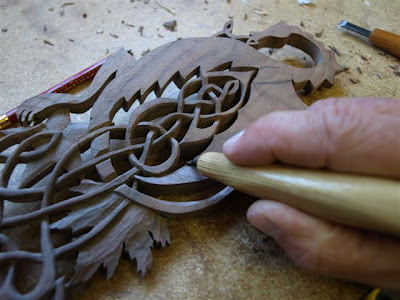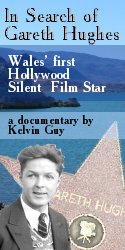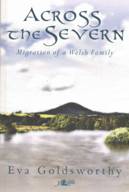Blogs
| In a blatant attempt to increase traffic Americymru has been reduced to playing silly Twitter games. If you have a Twitter account you can join in the "fun" here:-: |
Mike Jenkins describes his first blogpost thus:-"My very first blog.I'm a virgin blogger. I wonder if anyone out there will even bother to read it. Well, I'm used to that , being a poet!"In our humble opinion such modesty ill befits the author of this magnificent poem:- The Journey of The Taf ....first published on Americymru in April this year. We look forward to reading future posts. Mike must not blog in vain:)
|
The Left Coast Eisteddfod will be the centerpiece of a program in the PDXposed television series on Welsh culture in Portland. The half hour long show, which will air on the FOX network in November, will include live footage and interviews from the Eisteddfod itself and will highlight the activities of the Welsh community in the Rose City. There is a possibility that the program will be available to viewers outside the Portland area "on demand". The producer and crew of PDXposed will be traveling to Wales in September to do a travel show on location to be aired here in Portland. Final locations and subjects aren't yet pinned down and this is still in the planning stage with some logistics and productions to be worked out. PDXposed has worked out this trip with the very able assistance of AmeriCymru member Paul Chibeba from VisitWales . Some past episodes of PDXposed are available on youtube HERE In addition to filming at the Eisteddfod, PDXposed presenter Jon Olson expressed an interest in filming a sports activity (rugby, of course!) and people in a restaurant or pub and we suggested meeting them at the Horse Brass on Belmont, if the owners are amenable. We need as many Welsh people and people of Welsh descent as are willing to show up. If you're in the Portland area, please tell us you're willing to drink for Wales at the Horse Brass during the week before the Eisteddfod. Volunteer in the comment box below. Uncle Dai needs YOU! We strongly advise anyone planning to travel from outside Portland to attend the Eisteddfod to buy tickets well in advance as we predict that demand will be high in the coming months. Visit the main Left Coast Eisteddfod page HERE .
|
We are very pleased and proud to announce that a copy of "In Search of Gareth Jones" is being made available to us by its creator, Americymru member Kelvin Guy , for showing at the Left Coast Eisteddfod in Portland . The documentary will be shown in Lola's Room in the Crystak Ballroom on Saturday August 22nd ( precise time to be announced ). For more information about Gareth Evans see below or visit the film's website HERE .
About Gareth Hughes - From the Wikipedia
Born into a working class family in Dafen, Carmarthenshire, after undertaking some local amateur roles aged 15 he walked to London and joined a West End theatre based group of Welsh players. The group took a tour to the United States, and although not successful Hughes was spotted in New York, and left the group to take a series of minor roles on Broadway. Seen by the right people, they persuaded Hughes to get involved in the new-fangled picture business.
Hughes earlier screen work was with Clara Kimball Young in Eyes of Youth, Marguerite Clark in Mrs. Wiggs of the Cabbage Patch. He was teamed with Viola Dana in The Chorus Girls Romance, and was with Famous Players-Lasky Corporation, in Sentimental Tommy, the picture which attracted immediate attention to his ability. Even though he had already appeared in many films before this,he always regarded Sentimental Tommy as his favourite and most successful. In total he made forty five films spanning 1918 to 1931.He was also the Welsh dialect coach, on The Corn Is Green made in 1945 starring Bette Davis (another Welsh connection). Ceil.B.DeMille called him a young idealist. Fulton Ousler describes him as the charm boy to end all charm boys
In 1929 like many others he lost his fortune in the Wall Street crash and was left penniless, but he carried on making films until 1931 when he appeared in Scarce Heads. He then decided to leave the world of film and return to theatre, which he had always been his first love. His last performance ran for 18 weeks at the Hollywood Playhouse in 1938, where he starred as Shylock in the Merchant of Venice.
In the early 1940s Hughes decided it was time to leave his full and exciting but also lavish and selfish lifestyle. Adopting the name of Brother David, in 1944 he became a missionary to the Paiute Indians on the Pyramid Lake Reservation of Nevada. Hughes spent almost 14 years with his children as he liked to call them.
In 1958 Hughes decided to return to Llanelli to spend his final years. But he longed for the sunshine of the West Coast, and after five months he returned to California. Later Hughes moved into the Motion Picture Country Home, in Woodland Hills, where he had his own cottage. He baptised silent film actress Clara Kimball Young prior to her death. There he died at the age of seventy, and his cremains were buried in a Masonic Cemetery at Reno, Nevada.
In 2008, Hughes relative Kelvin Guy made made the film Desert Padre , which premiered in Llanelli.
Author’s tribute to her parents’ “awesome courage” in the face of anti-Welsh sentiment
By Ceri Shaw, 2009-06-15
Across the Severn is Eva Goldsworthys heartfelt tribute to her parents, who were forced to uproot themselves from Wales after the 1921 miners strike and had to face down anti-Welsh sentiment when they moved to England. The author says, This book is an account of two people I loved. From one angle their lives were uneventful but they illustrate the great courage inherent in the Welsh as a people the way they stick to a task and make the best of difficult circumstances. May and Joe stayed true to this tradition even though they would have been the last to admit it.
More than a familys story, Across the Severn is also an excellent piece of social history. Events in the lives of the protagonists are constantly rooted in the wider context of the turbulent politics of the early 20th century. Goldsworthy examines the devastating effects of pit closures in the Valleys and the 1921 miners strike, which left her father with no choice but to seek work in hostile England. On a trip home to Ogmore Vale in 1926, the author observed firsthand the obvious signs of poverty following the General Strike. She says, I remember boarded-up shops and thin, grey-faced men hanging around on street corners. The coal mine owners had taken their revenge and there had been savage cuts in employment, most of all for the so-called agitators. The burning aim of most of the youngsters in Ogmore was to get out.
The author also includes her reminiscences of the time she spent working on the development of radar and nuclear fission during the Second World War. Socialism, the emancipation of women, and the swan-song of the English gentry are amongst the other wide-ranging topics which form a background to this fascinating story of how individuals coped with the difficulties they faced during an era of unprecedented change.
Eva Goldsworthy was born in Wales but spent most of her life in London as a mathematics teacher. She has three daughters and now lives in Llanfyllin. She is also the author of A Flat-Pack in Greece.
Reprinted with permission from David Western's blog , all material 2009, David Western --

This week I'm doing the back side of the dragon's wing. Because this particular design is kind of a 2 1/2 Dimension carving, I want to make sure that I don't just repeat the front pattern as there is a wing passing over the other. As with all the other sections of the spoon, I do a quick bit of pencilling to make sure everything is where it should be...THEN I commit to the knives.

Here I cut down a section to separate the back wing from the front wing. Visually, the back one should overlap the little visible section of the front wing just as the reverse has happened on the front of the spoon. Confusing? It can get that way if you don't sketch things out! As I'm only working to 2.5D and not a full on 3D, I will keep the wings as opposite faces of the spoon, rather than trying to separate them completely. If the spoon were a bit thicker and I wasn't concerned about it getting too delicate, I would be inclined to do separated wings. Doing that would leave me with very thin wings which would be extremely susceptible to breakage...probably not a good thing for a dragon who is going to brave the hurly burly of an Eisteddfod evening!

With the facets of the wing marked out and the front portion clearly deliniated, I can start getting set to shape each section of the wing.

I have started to clear out material to create each fold of the wing. I use the bent knife to do the bull work and then smooth things out with a straight knife or with a bent knife with a shallow curve. I like to leave the surface a bit textured as it makes the wing look a bit more lively and a bit less processed than dead smooth faces. I generally cut from the bottom fold and move up to the top of the wing. That way, if I have a knife slip and take a bit off the fold in front, it isn't as calamitous a situation as it is to whack a finished section!

And thar she be. This is far as I will take the wing for the time being. After the spoon is pretty well completed, I'll come back over any rough areas and tidy things up for the final inspection, but this is pretty good for the moment.


These two pictures show the effect I am after with the wings passing over each other. A bit more exciting than 2D but not as dangerous as 3D! But don't despair if you are like a car racing fan who has come to see the pile-ups....I may have got this far unscathed, but there are plenty of opportunities for disaster still to come! It's what makes lovespoon carving the thrilling pastime it is!!




